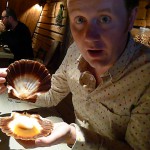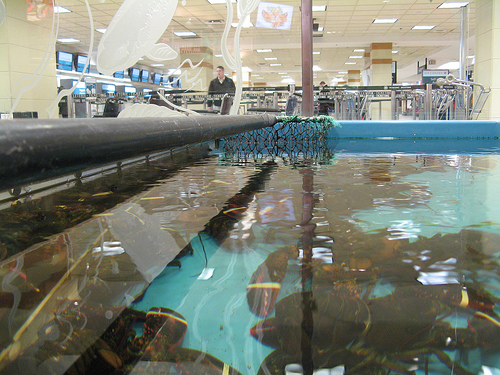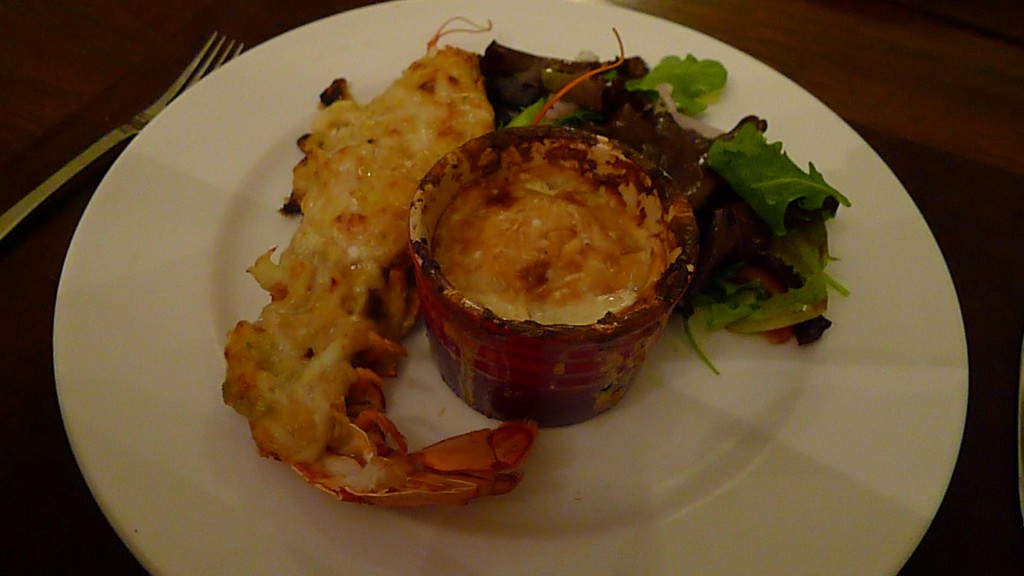I first met my erstwhile friend Freddie in Halifax’s Stanfield airport on the way back from covering both the Canadian Chefs Congress and the CAPS final for Good Food Revolution earlier this month.
The memory sticks in my mind as I recall being rather amazed at the concept of being able to purchase live lobster at the airport; lobster that would then be packed carefully enough to allow it to get through security as carry on on my return journey to Toronto. After making a brief acquaintance with Freddie he was quickly wrapped in dense, moist towels and then expertly packed into a cleverly designed carry case.
Clearwater, the company selling the lobsters, used to pack shellfish up with ice packs for their flights, but since the introduction of much tighter airline security in 2006 and the consequent restrictions regarding the transport of liquids and gels, they had to get creative. For a while they wrapped the little fellows up in bags of frozen peas. These days the boxes, which can hold up to 15 of the beasts, are lined with the aforementioned bed of saltwater moistened cloths.
And so, after watching Freddie pass through the X-ray machine at security with some amusement as he wriggled around and made himself comfortable, we journeyed to Toronto, and I found myself back home with a live Nova Scotian lobster. Now, apart from the perfunctory introduction to Harvey my catpanimal, what to do with said lobster?
It is recorded in many a text that the Lobster Thermidor was invented in 1894 at the Parisian restaurant Maire on the Boulevard Saint-Denis. Legend has it that the dish was named to celebrate the opening of Victorien Sardou’s controversial play “Thermidor“, a play that was consequently banned after a mere three performances as it subject matter of The Revolution (the Thermidorian Reaction led to the end of the Reign Of Terror) was still a little too fresh for the audience of the day.
History aside, I felt that an attempt at resurrecting this indulgent, extravagant, and rather archaic dish would be a grand idea.
Not wishing to pull a Wente on you I’ll go for complete transparency here and admit that I took Hugh Fearnley-Whittingstall‘s take on the classic recipe and hacked at it for a bit, utilising the contents of my larder and spice cabinet as is de rigueur for any decent home cook.
Here’s what I came up with… and it was exceptionally good.
- 1 live lobster, weighing between one and two pounds
- 2 fresh shallots, finely chopped
- 1 Clove of garlic, minced
- A healthy knob of butter
- A large glass of white wine
- 200ml thick and spicy béchamel sauce (see below)
- 2 tablespoons whipping cream
- 1 teaspoon strong and hot English mustard (well… mine was Austrian, but you get the idea)
- 1 teaspoon of Chinese Five Spice
- 50g Gruyère cheese, grated
- 2 Tablespoons of freshly grated Parmesan
- 1 teaspoon of cayenne pepper
- 1 teaspoon of grated fresh ginger
- 1 kaffir lime leaf, finely chopped
- Salt and freshly ground black pepper
For the rather indulgent Béchamel sauce
- 1 carrot
- ½ an onion
- 1 celery stick
- 1 bay leaf
- 1 black cardamom pod
- 250ml of full cream milk
- A good knob of good butter
- 25g plain flour
- salt and freshly ground black pepper
METHOD
How to make my Asian NS lobster thermidor
1. Say goodbye to your lobster and then put them in the freezer for 2-3 hours… he’ll have a wee schleep in there… Then put it straight into a big pot of rapidly boiling salt water (use a ratio of 30g sea salt to each litre). I found it better to add a quartered lemon, 3 bay leaves, chopped celery, carrots, and onions to the water as it added a little extra to the lobster meat. This is probably the most humane way to finish off Freddy, and prevents his tail from thrashing about and splashing boiling water all over the place. Cook for 15 minutes for a lobster of 1lb and an extra five minutes for every half pound over that. Leave to cool.
At this point, upon the passing of my wee pal Freddie, I felt it essential to play the following:
2. To make the béchamel (my favourite sauce, I used to want to call my daughter Béchamel), grate the vegetables and place them in a saucepan with the bay leaf, cardamom pod, and milk. Bring to the boil, then take off the heat and leave to infuse for about an hour. Strain out the vegetables and bay leaf, then put the flavoured milk in a clean pan and reheat gently, but do not allow it to boil.
3. Melt the butter in a separate pan and stir in the flour. Cook this roux gently for a couple of minutes (I think that the most common mistake that folks make when making a roux is not cooking the flour through properly), then whisk in the milk, a third at a time, to get a nice smooth sauce. Let it simmer very gently for 5 minutes. It should have a pouring consistency, but to be quite honest I prefer it when it begins to look more like blamange.
4. Set aside, with a piece of clingfilm on the surface to stop a skin forming.
5. Twist off the lobster’s claws, crack them with a hammer or nutcracker and remove all the meat. Set this aside. The body of the lobster should be split lengthways along the lateral line with a large, heavy and very sharp knife. This is most easily done if you lay the lobster on its back on a large wooden board.
6. Press the point of the knife into the tip of the tail, and bring the knife down the length of the lobster, bisecting it evenly between the two sets of legs – do this carefully so as not to damage the shell. Once you are through the flesh to the shell at the back of the lobster, press hard on the knife with your free hand to cut through the shell.
7. You may want to use a pair of kitchen scissors to snip through any bits of shell that are not quite cut through.
8. Carefully remove the tail meat from each half of the lobster, chop roughly and add to the claw meat. Scrape out any brown meat from the head, yes, all that gunky looking stuff, it is tasty… along with the pink coral, and add that to the white meat from the claws and tail.
9. Remove the dark gut that runs along the top of the tail (although strangely enough there was NOTHING within Freddy… which makes me wonder about how long Clearwater had him in “stasis”), the small gritty sac behind the mouth, and the gills, and discard. You should be left with 2 empty shell halves, with plenty of space in the head and tail cavities to replace the finished meat. I gave them a good wash out in the sink and then left them to dry.
10. In a frying pan, sweat the shallots, ginger, and garlic in the butter over a medium heat until soft and lightly browned. Add the white wine and simmer until reduced to a scant tablespoon of liquid. Stir in 200ml béchamel sauce and the double cream, if using, plus the mustard, lime leaf, and Five Spice, and allow to bubble in the pan for just a minute.
11. Remove from the heat and stir in the grated cheese and the cayenne pepper. Then mix in all the meat from the lobster until it is well coated in the sauce. Season to taste with salt and black pepper.
12. Pile the meat back in the shell, sprinkle over the parmesan cheese and place under a hot grill for 5-10 minutes, until brown and bubbling. Serve at once.
…
 Edinburgh-born/Toronto-based Sommelier, consultant, writer, judge, and educator Jamie Drummond is the Director of Programs/Editor of Good Food Revolution… And he is amazed that the two of us managed to finish it all… seriously delicious.
Edinburgh-born/Toronto-based Sommelier, consultant, writer, judge, and educator Jamie Drummond is the Director of Programs/Editor of Good Food Revolution… And he is amazed that the two of us managed to finish it all… seriously delicious.










